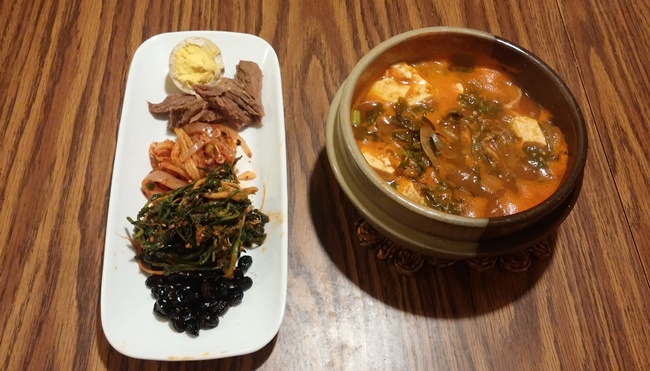엊저녁에 딸아이가 밥상에서 저의 부부에게 물어본 말이랍니다. “한국식 반찬을 어떻게하면 빠르고 쉽게 만들어 먹을 수 있지?” 아내와 저는 순간적으로 나름 아는 지식을 총동원해 이런저런 이야기들을 해주었답니다. 그러나 우리 부부의 응답이 아이에게는 닿지 않는 분위기였답니다.
아무렴 쉽게 살자면야 뉴욕인데, 한국마켓에 가서 사먹으면 간단히 해결될 문제겠지만 그래도 아이가 제 먹거리를 스스로 만들어 먹는 일로 생각하고 묻는게 고마웠답니다.
그래 오늘 아침부터 부산을 좀 떨었답니다. 아이가 먹을 밑반찬을 만들어 보내노라고 말입니다. 콩자반, 장조림, 오징어젓갈을 만들어 조금씩 싸서 넣어주었답니다.
내친김에 농사짓는 친구가 보내준 무우로 석박이와 물김치도 좀 담구었구요.
아마 엊저녁에 제가 “징검다리”를 떠올려 생각한 것은 모두 제 딸아이 덕이랍니다. 그 맘으로 오늘 제 가게 손님들에게 보낸 편지랍니다. 그리고 오늘 저녁 우리 부부의 밥상이랍니다.
<이런 조촐한 밥상을 함께 나누려 애쓰는 이들을 생각하며…>
예전에는 아주 흔히 볼 수 있었던 것들인데 지금은 거의 찾아볼 수 없는 것들이 있지요. 그런데 비록 볼 수는 없더라도 그 이름만은 남아서 사람들이 오늘날에도 흔히 사용하는 말들이 있지요. 어떤 것들이 있을까 한번 생각해 보는 일도 재미있지 않나요?
제가 어릴 적에만 해도 한국에서 흔히 볼 수 있었지만 지금은 한국에서없어진 것들 중에 징검다리라는 것이 있답니다. 징검다리라는 것은 거의 없어졌지만 한국사람들은 이 말을 아직도 사용한답니다.
예전 한국의 전형적인 마을 구조를 보면 작은 산 밑에 집들이 몇채 있어 마을을 이루고 마을 앞에 농사를 짓는 논과 밭이 있고, 그 논과 밭 끝에는 작은 개울이 있답니다. 그 개울을 건너면 또 다른 마을이 시작되는 것이고요.
그 개울에는 다리가 놓여져 있었답니다. 지금 “다리”라는 말에 당신이 상상하고 있는 그런 모습의 다리가 아니랍니다.
바로 이 사진과 같은 모습의 다리랍니다.
개울 위에 큰돌들을 사람들의 보폭만큼의 간격으로 이어놓은 다리랍니다. 이런 징검다리를 거의 볼 수 없지만 예전에는 어느 동네에서건 아주 흔히 볼 수 있었답니다.
그런데 비록 징검다리의 모습은 볼 수없지만 “징검다리”라는 말은 아직도 아주 자주 사용하는 말 가운데 하나랍니다.
‘징검다리’라는 말은 이쪽과 저쪽을 이어주는 것이라는 뜻으로 쓰이기도 하거니와, 누군가에게 도움을 주는 역할을 한다라는 뜻으로도 쓰인답니다.
자! 11월 마지막 일요일이고 이틀 후면 12월입니다.
12월은 2015년의 마지막 달이자 2016년을 이어주는 징검다리입니다.
올 한해동안 함께했던 기쁨과 즐거움을 내년에도 이어주는 동시에 누군가에게 힘과 희망을 심어주는 징검다리 같은 올 한해 남은 시간들이 되시길 빕니다.
There are many things that could commonly be seen in the old days, but that have almost disappeared nowadays. But, even though they cannot be found easily, their names still remain to be used so often. Don’t you think that it is interesting to think about those things?
Among those things that could commonly be seen when I was young, but that have almost completely disappeared in Korea, one thing came to my mind. It is “Jing-Gum Dah-ri.” “Dah-ri” means “a bridge.” Though it is very difficult to find any of these now, people in Korea are still using the words.
In the old days in Korea, a typical village in the countryside was located at the foot of a small mountain, and had rice paddies and farming fields in front. And at the end of the farming area was a small creek. If you crossed the creek, you would step in a different village. In a word, the creek made a border between two villages.
A bridge traversed the creek. Even though I said a “bridge,” it was not the kind of bridge you might have imagined.
It was a kind of bridge as shown in this picture.
It was a bridge which was made by putting big rocks at the intervals of a person’s stride in the creek. Nowadays, this kind of “Jing-Gum Dah-ri” is very difficult to find, but in the old days, it could be seen in any village.
Even though they have almost disappeared completely, the word, “Jing-Gum Dah-ri,” is still one of the frequently used words.
As its function indicates, it is being used to mean what connects this and that, and also what plays a role to help someone.
There, There! It is the last Sunday of November and December will start in just two days.
December is the last month of 2015 and a “Jing-Gum Dah-ri” to connect 2015 to 2016.
I wish that all of you will have the remaining days of 2015 like a “Jing-Gum Dah-ri” which connects and extends all the joys and happiness in this year to next year and which inspires someone with hope and strength.



